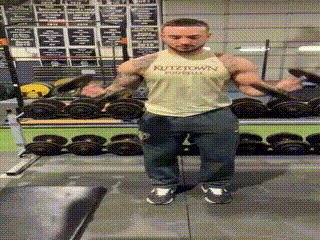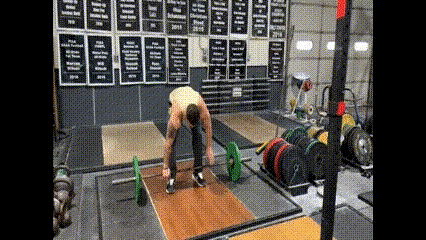What Is A Pull Day Workout?
What Is A Pull Day Workout?
Lifting with the upper body is a primal feeling of strong. There is nothing that sells, “I lift weights” to a non-gym goer like broad shoulders, a wide back, and arms like bazookas. Typical bodybuilder type of stuff. Typical powerlifter type of stuff. Typical weightlifter type of stuff. The type of strength that can be developed using our strength training app, Peak Strength. But not all strong physiques are created equal.
The burliness of thiccc takes a trained eye to notice the inherently strong body being gazed upon. Whereas lean calisthenic devotees and open field sport participants each have a lean sheen of muscle that takes on a more apparently strong appearance. Us normal, young, ageing, or elite devotees to the athletic physique understand the work it takes and, that when it comes to the upper body, it isn’t all push. We need our fair share of pull too.

Mountainous pecsare nice, but they’re nothing without the great, open expanse that is the back. In our backs, we have our rear delts, our lats, our rhomboids, our traps, our erector spinae, our scaps, and a host of other muscles our more anatomically educated among our ranks can name with specificity.
To train and develop a wide back to come across like a mountain that rides, we have to implement pulling movements into our lifting routines.
Let’s dive into how to construct a legit pull day workout to not only beef up those lats, but improve athletic performance, particularly for athletes who wrestle, grapple, clinch, or need to hold onto an opponent blocking or pull in an opponent for a tackle. Or, maybe you just want to develop a more globally pleasing athletic physique.
Pull Day Workout
Pulling exercises are not all upper body exercises. The deadlift is a pulling motion. The power clean and power snatch each have a pulling component involved in their execution. The hack lift is a pulling motion that hammers down on the quads, and the hamstring curl, Nordic curl, and razor curl all ask the hamstrings to pull, pull, pull. Even a pretty small, specific movement like tibialis raises have a pulling component, namely being responsible for ankle dorsiflexion strengthening so that you are able to bring your toes toward your knees.
All great exercises! Though not necessarily the most impactful exercise for sports performance training, the deadlift is a kaiju level exercise movement that does wonders for the raw, absolute strength in the posterior chain. With Garage Strength Program Design, the preference though orbits around quick, dynamic pulls performed in the initiation of Olympic weightlifting movements like the clean and snatch, or what we call Technical Coordination movements at Garage Strength (if you are interested about learning more about programming technical coordination movements, check out Parabolic Periodizationand upgrade that gray matter because someday it may matter).
Maybe a little late but, to be abundantly clear, this article is going to focus on pulling movements to help assist the upper body.
Often, we think of the upper body and think about pushing weights away from the body. Exercises like the bench press, incline bench press, or overhead press come to mind for absolute strength movements. The jerk, push press, and PA press come to mind when talking technical coordination movements–essentially moving heavy weight fast, a key to athletic development in sports performance for optimal transfer of training. Accessory movements to help develop those pressing muscles involve exercises like the miracle gro, Telle extensions, Tate press, and dips.
But for a truly strong upper body, we need to train the antagonist muscles to our pressing muscles. To do that, we can’t just think of our pulling muscles as stabilizers to accentuate our pressing abilities. No, no, no! We need to think of our pulling muscles in the agonist role. We need to see our pulling muscles in a way that make them a targeted focus in training.
We can do this by training our pulling muscles in the same vein we would our pressing muscles.
How do we do that you might ask?
Let’s learn.
Upper Body Power Day
Garage Strength Program Design teaches us to structure our training around a LULU split. LULU is an acronym for Lower, Upper, Lower, Upper. GSPD almost always throws an Athlete Day in the middle of the first LU and the second LU. This is a very similar training split to that used within the Peak Strength App.
On the Upper Body Power Day, we want to lift with the intention of developing power and strength. So, for instance, if we want bigger pressing muscles for that rapid elbow extension, we’ll train using the bench press to get that dynamic correspondence that comes from performing the exercise with rapid elbow extension.
The same idea can be applied from a dynamic correspondence standpoint with pull ups if we are looking to improve our pull through the water with swimming, or our completion of a takedown on the mat once securing that single leg on the shot.
We can set up an upper body power day by beginning with a technical coordination movement. Technical coordination exercises have the purpose of moving heavy weight fast. Like mentioned before, think of technical coordination movements as Olympic weightlifting exercises and their related variations.
Typically, on an Upper Body Power Day, we would use a jerk, push press, or PA press as a legitimate technical coordination exercise. But since this is a day specific to developing pulling strength, we can bias our exercise selection to accommodate.
A great way to do this is by performing a snatch high pull or a variation of the movement. One exercise that we love here at GS in this instance is the pump snatch, or better yet, the Horst Pull. Both exercises are terrific and incorporate a vertical pulling motion in a dynamic manner for proper execution.
Following the technical coordination exercise is the absolute strength movement. Absolute strength movements typically align with powerlifting exercises, namely the squat and bench press, along with their variations like the front squat or incline bench press. In that regard, for a pull day workout, weighted pull ups or heavy barbell rows (and of course their variants) rule the roost in this instance.
Usually, the spot of the absolute strength exercise on the Upper Body Power Day is reserved for the bench press. However, on an upper body day where the exercises are being biased towards a pull day workout, it can take a backseat or at least ride shotgun.
With the technical coordination exercise and absolute strength exercise(s) completed, that leaves accessory movements to finish off the day. In a pull day workout scenario, we want to select movements that target the biceps, lats, and the various musculature in the back that build upon that wide expense.
Having the first day of upper body training focused on developing power and raw strength for better impulse expression, the second upper body workout in the week seeks to put on muscle mass. That day is Hypertrophy Day.
Hypertrophy Day
Hypertrophy day follows a very similar structure to the Upper Body Power Day. It begins with a technical coordination exercise, which is followed by an absolute strength exercise, and finds the workout being ended with accessory movements.
However, where the Upper Body Power Day centered around developing power and strength, the Hypertrophy Day focuses on structural bodybuilding, pre-habing potential trouble areas, and building lean muscle mass because, let’s face it, bigger muscles have the ability to generate more force.
Like Hypertrophy Day’s name implies the day’s intention of building bigger muscles through structural bodybuilding, the act of increasing musculature around joints to increase stability and tendon integrity, involves a lot of chasing the pump, getting swole, and gym bro’ing out.
The bodybuilding mindset means longer time under tension, big sets of 17 reps, and all the sarcoplasmic, hypertrophic, pump inducing gainz.
Exercises (6)
With all that programming knowledge in mind, let’s look at 6 exercises that can contribute greatly to a pull day workout to develop an athletic physique, a strong back, and musculature that provides on the field, court, and mat success.
To do this, we’re going to look at two accessory movements, two absolute strength movements, and two technical coordination exercises.
6. Meadows Row (Accessory Exercise)
Named after the man himself, John Meadows, the Meadows Row is a mainstay in a pull day workout. The Meadows Row is great for the lats, rear delts, rhomboids, traps, forearms, and biceps.

Any wrestler who has trained at Garage Strength knows the infamous Zottman curl.
Bicep curls are a hallmark of any pull day workout. The Zottman curl, though not necessarily the best for peak loading and the highest intensities, is more notorious for the forearm burn it accentuates during the eccentric portion of the movement.
Having a dumbbell in each hand, you perform the concentric portion of the lift like a typical dumbbell bicep curl, having your hand in a supinated grip. However, during the eccentric of the Zottman curl, you pivot your hand, so your grip is pronated as the dumbbells are lowered.
It is important to control the eccentric to increase that time under tension and really feel the forearms work here. The burn is for real. Better yet, as the muscles begin to fatigue, you will feel muscles in your back start to engage to help you hold on to the dumbbells.
As is the case with most swole chasing pump fest exercises, you want reps to be in the neighborhood of 17+.

The pull up is the back squat of the upper body (which makes the bench press the front squat of the upper body). A bodyweight pull up is no laughing matter in and of itself. Add in the dead hang and the difficulty increases. Then add weight and you just put the difficulty slider on hardcore.

The Hater Row is incredibly similar to bent over row, but juiced up on co-contractions and a bit of ego.
The Hater Row is performed around the idea of using the legs and other musculature to put a little English and momentum on the barbell to allow for greater intensity with loading.
It is highly recommended you use straps when performing the Hater Row. To perform the Hater Row, grip the bar where you would typically hold it for a deadlift, a clean pull, or a bent over row. From there, set up as if you were going to perform a row. But instead of trying to do the movement as strict as possible, perform the lift with more of a ‘heaving’ action. Make sure you are still performing a row and not some misguided clean pull, but also make sure you’re doing it with enough of a ‘cheat’ to handle the overloaded weights.
Reps in the neighborhood of 6 to 8 for sets work here.

Want massive traps? Do this exercise.
Want to be explosive AF? Do this exercise.
The snatch itself will get you massive traps, but sometimes that level of athleticism isn’t wanted or needed to accomplish a goal.
With that said, the ability to perform a snatch with full depth through a full range of motion should be achievable by athletes the world over. However, when the goal is only to target the upper body from a pull day workout lens, the two block snatch high pull will suffice.
To do this exercise, place a loaded barbell on blocks. With or without straps, take a snatch grip. With the snatch grip, pull the barbell in a rapid motion so that the barbell is achieving, at minimum, nipple height. The exercise needs to be done with maximal force. The intention is speed and impulse expression. Use the entirety of the body to execute the movement.
If you don’t have blocks, you can do this from the hang. Be warned, doing the movement from the hang will put a lot more strain on the lower back, so be cognizant of how that impacts your following lower body workouts.

The Horst Pull is the numero uno exercise for getting YOKED.
The Horst Pull is eerily similar to the snatch high pull and all its variations, except one major difference. The Horst Pull is performed while kneeling.
You may think this is silly, outlandish, and a waste of time. Swear to you, it is not. By performing the movement on your knees, you develop a whole new level of balance, dynamic trunk control, and an ability to coordinate musculature from the hips up through the upper torso.
The uniqueness of the movement is great for neurological adaptations.
To perform this exercise most effectively, you will want to use straps and have a foam balance pad under your knees, not only for comfort, but to have the ability to use maximal loads. From the kneeling position and with a snatch grip, take the barbell into your hip.
You will then explode through the hips and perform a high pull. You will rapidly recover into the starting position and instantly go into the next rep–boom! boom! boom! Performing each subsequent rep in quick succession creates a blast impulse rhythm and ensures swoleness will be upon your traps.

Sample Pull Day Workout (Upper Body Power Day)

Sample Pull Day Workout (Hypertrophy Day)


The Bottom Line
Going through a pull day workout for the upper body is taxing. If you are training to develop an athletic physique, that means you will be moving heavy weight fast, putting on lean muscle mass, engaging in structural bodybuilding, and performing exercises that bring about neurological adaptations. Selecting exercises that will make you more explosive, stronger, and build mass is needed to get the most out of your muscles for strength and athleticism to contribute to developing that wide, wide back.
Take either of the provided sample workouts and run through one of them next time you are in the gym. Or better yet, try both sample workouts over the course of a week when implementing that LULU split!
But if you are looking for a long-term fix, the premier strength development app for athletes, Peak Strength, will create a program from over 700 exercises (way more than what is provided here!) to sculpt that athletic physique you’re looking for. Try a week of workouts for free at peakstrength.app today!


EARL KUNKEL
3x World Champion Co-Author of the Year
King of the PA Press
Blog Topics

Yo, It's Dane
Welcome to the Garage Strength Blog, where it is my goal to provide you with the experience and knowledge I've gained in the strength and conditioning world over many years of learning from both successes and failures. I train elite-level athletes in a multitude of sports from the high school to professional levels, already producing 5 Olympics and 30+ National Champions. If you want to be the next champion I train, check out my strength programs below!
Start Training With Me

Join for free educational videos EVERY WEEK on strength coaching and athletic performance

